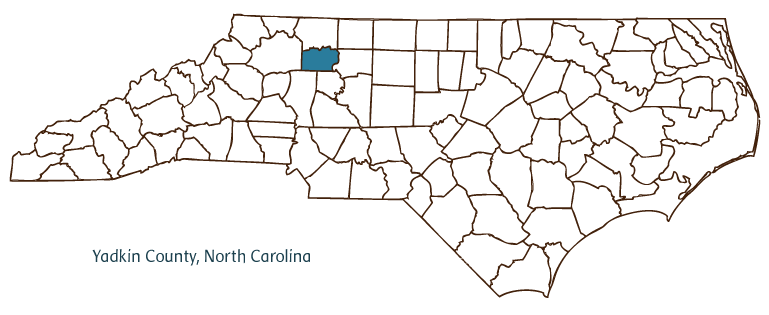Yadkin County Resources
- View All:
- Biographies
- Monuments
- locations
NCpedia and chat reference will be unavailable from 4:00 pm to approximately 4:30 pm on Friday, October 17th for maintenance. We apologize for the inconvenience.
Copyright Notice: This article is from the Encyclopedia of North Carolina edited by William S. Powell. Copyright © 2006 by the University of North Carolina Press. Used by permission of the publisher. For personal use and not for further distribution. Please submit permission requests for other use directly to the publisher.

Yadkin County, located in the Piedmont region of northwestern North Carolina in the foothills of the Blue Ridge Mountains, was formed in 1850 from Surry County and named for the Yadkin River. Early inhabitants of the area included the Tutelo and Saponi Indians, followed by German, Scotch-Irish, Welsh, and English settlers. Quakers also migrated to the area in the eighteenth century. Yadkinville, the county seat, was chartered in 1857 and named after the county. Other Yadkin County communities include Arlington, Jonesville, Boonville, East Bend, Courtney, Lone Hickory, Center Brooks, Marler, Smithtown, and Forbush. Notable physical features of the county include the Yadkin River, Brushy Mountains, Fox Knob, and Cobb, Beaverdam, Fall, Lineberry, Froeman, Cranberry, and Deep Creeks.
Yadkin County produces agricultural goods such as grains, tobacco, corn, soybeans, apples, livestock, and poultry. Manufactured products include textiles, hosiery, plastics and styrofoam, furniture, apparel, and stainless steel. Minerals such as feldspar, agate, jasper, limestone, mica, and iron ore are found in the county.
Yadkin County landmarks include the Tulbert House, built around 1852; Bourman Mill Dam, built in the late nineteenth century; and Deep Creek Friends Meeting Cemetery, established around 1801. Richmond Hill, once a law school and home of North Carolina Supreme Court chief justice Richmond Pearson, is now a historic park. Cultural institutions in Yadkin County include the Charles Bruce Davis Museum of Art, History, and Science and the Yadkin Arts Council. The county hosts popular events and festivals such as the Yadkinville Harvest Festival, Yadkinville Annual Magic Show, Boonville Heritage Days Festival, and Yadkinville Bluegrass Contest and Fiddlers' Convention. Yadkin County's estimated population was 37,000 in 2004.
For an annotated history of the county's formation, with the laws affecting the county, boundary lines and changes, and other origin information, visit these references in The Formation of the North Carolina Counties (Corbitt, 2000), available online at North Carolina Digital Collections (note, there may be additional items of interest for the county not listed here):
County formation history: https://digital.ncdcr.gov/Documents/Detail/the-formation-of-the-north-ca...
Index entry for the county: https://digital.ncdcr.gov/Documents/Detail/the-formation-of-the-north-ca...
References:
Frances H. Casstevens, Heritage of Yadkin County (1981).
William E. Rutledge, Illustrated History of Yadkin County, 1850-1908 (1981).
Additional resources:
Corbitt, David Leroy. 2000. The formation of the North Carolina counties, 1663-1943. https://digital.ncdcr.gov/Documents/Detail/the-formation-of-the-north-carolina-counties-1663-1943/3692099?item=4553233 (accessed June 20, 2017).
Yadkin County Government: http://www.yadkincountync.gov/
Yadkin County Chamber of Commerce: https://yadkinchamber.org/
DigitalNC, Yadkin County: https://www.digitalnc.org/counties/yadkin-county/
North Carolina Digital Collections (explore by place, time period, format): https://digital.ncdcr.gov
Image credits:
Rudersdorf, Amy. 2010. "NC County Maps." Government & Heritage Library, State Library of North Carolina.
Bayley, Elizabeth. "Yadkin County." NCpedia. State Library of NC. 2006. https://www.ncpedia.org/geography/yadkin.